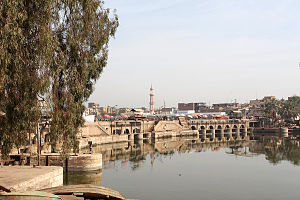 Weir in Dairut, which divides the Ibrāhīmīya Canal into the Baḥr-Yūsuf and Ibrāhīmīya Canal, among others | ||
| Ibrāhīmīya Channel · الترعة الإبراهيمية | ||
| length | 350 km | |
|---|---|---|
| location | ||
The Ibrahimiya Canal (Arabic:الترعة الإبراهيمية, at-Turʿat / at-Tirʿat al-Ibrāhīmīya) is an irrigation canal in Middle Egypt on the left Nile sidewho is in Asyūṭ begins. The canal, which is around 350 kilometers long and completed in 1873, is one of the longest man-made canals.
background
The Ibrāhīmīya Canal represents a major infrastructure project in Egypt that served to irrigate and enlarge the cultivation area to the left of the Nile. The canal runs more or less parallel to the Nile, but it is no more than four to five kilometers from the river. The started in 1867 and in 1873, at the time of Khedives (Viceroy) Ismāʿīl Pasha, completed canal was once mainly used for year-round irrigation of the sugar cane fields. At times up to 100,000 workers were employed in building the canal.
However, before the construction of the Aswan Dam, the canal's flow rate fluctuated between 30 to 80 cubic meters per second in summer and 500 to 900 cubic meters at the time of the flood of the Nile. The irrigated area is about 2,300 km2. With the completion of the by British civil engineer William Willcocks (1852–1932) constructed weir in Asyūṭ in 1901, the flow rate of the canal could be better regulated.
The canal begins with a canal weir in Asyūṭ and runs over 60 kilometers Deirūṭ, where the Ibrāhīmīya Canal is divided into the Joseph Canal, the Balicherr Yūsuf, to the west, and the Ibrāhīmīya Canal to the east, further above Mallawī at km 90, el-Minyā at kilometer 120, Maṭāi at kilometer 160, Maghāgha at kilometer 190, el-Sharāhna at kilometer 210 and Beni Suefuntil he returns to the at el-ʿAyāṭ at km 350 Nile flows out.
With the Nile weir in Asyūṭ The possible water inflow for the Ibrāhīmīya Canal also increased due to the now higher Nile level.
getting there


Arrival is usually only possible by car or taxi, on site also on foot. There are country roads on both sides of the canal. On the right-hand side of the canal, the railway line from runs at a more or less large distance Cairo to Aswan. There are bridges over the canal, especially in the towns and villages on the canal.
Tourist Attractions
- 1 Canal weir in Asyūṭ (كوبري الترعة الإبراهيمية, Kūbrī at-Turʿat al-Ibrāhīmīya). The weir, which is located 500 meters south of the old Asyūṭ weir, is about 100 meters long and has openings nine five meters wide. There is a lock in the north of the weir.(27 ° 11 '44 "N.31 ° 11 '8 "E)
- 2 Deirūṭ weir (قناطر ديروط, Qanāṭir Dairūṭ). The weir, which was built in 1870 and is around 170 meters long, divides the Ibrāhīmīya Canal over six individual weirs, including the Baḥr Yūsuf and the Ibrāhīmīya channel. It is the most technically demanding weir along the Ibrāhīmīya Canal.(27 ° 33 '32 "N.30 ° 48 ′ 41 ″ E)
- Further weirs are in Mallawī, in el-Minyā, in Maṭāi, in Maghāgha and in esch-Sharāhna.
kitchen
Restaurants can be found in the neighboring provincial capitals, and food stalls in the towns in between.
accommodation
Accommodation is available in the neighboring provincial capitals.
literature
- : Egyptian irrigation. London, New York: Spon, 1913 (3rd edition), Pp. 434-441 (Volume 1), pp. 554-556 (Volume 2). 2 volumes.
- : Irrigation in Egypt. Washington: Government Printing Office, 1889, P. 38 f.



